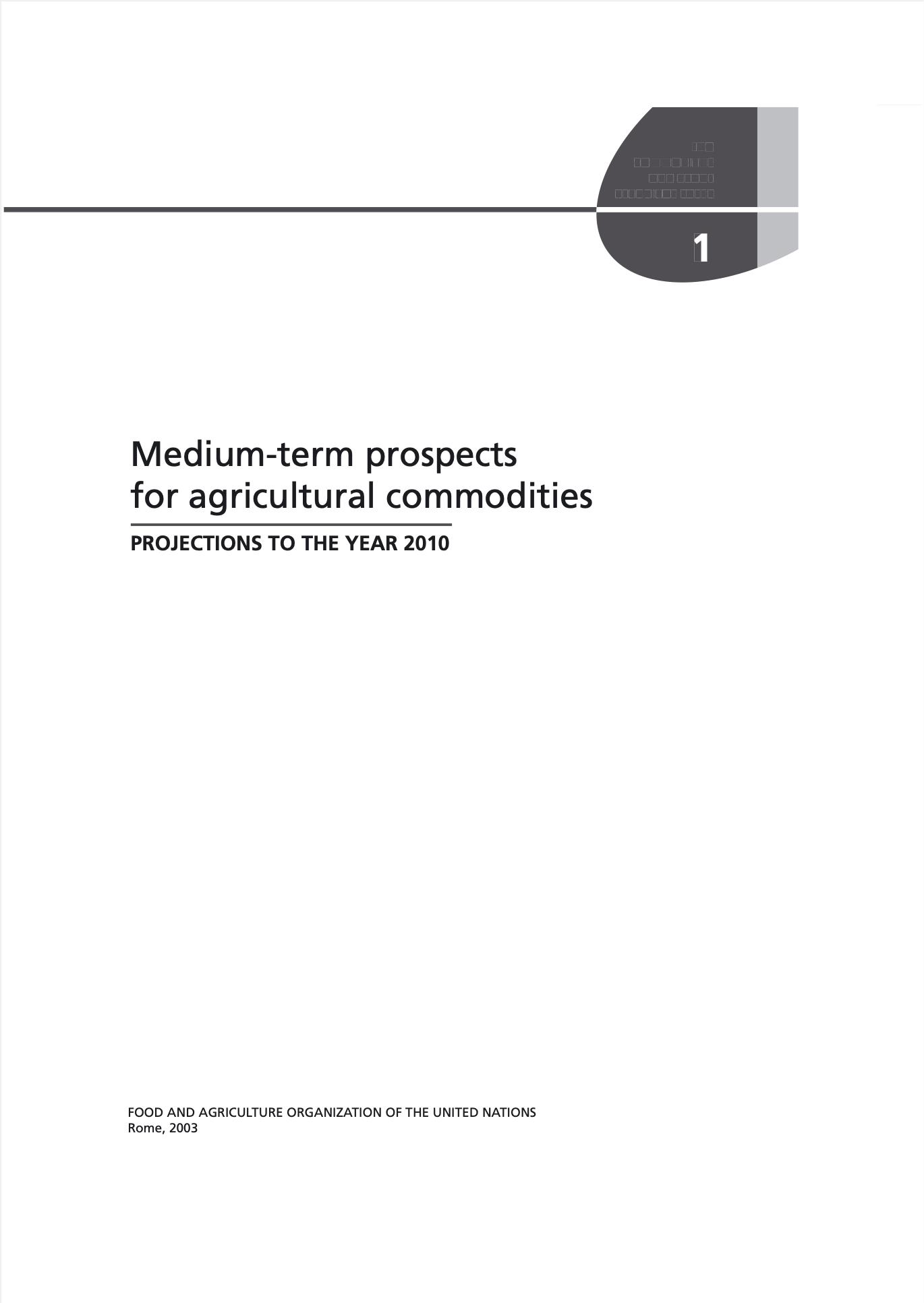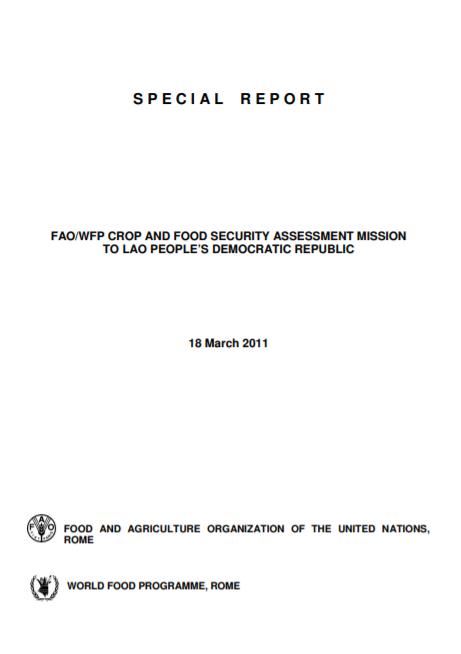
Special Report - FAO/WFP Crop and Food Security Assessment Mission to Lao People's Democratic Republic
27/10/2011
Prompted by concerns about a very weak start to the rainy season in parts of Lao PDR (and in much of the surrounding region) which was then followed by excessive rainfall and flooding in several areas later in the season, the Ministry of Agriculture and Forestry (MAF) requested a joint FAO/WFP Crop and Food Security Assessment Mission to evaluate the 2010 main paddy crop, forecast the 2011 irrigated crop and assess the overall food situation, import requirements and food aid needs, if any, for the 2010/11 marketing year (January/December). The last such mission had taken place in 2001, following serious regional flooding.
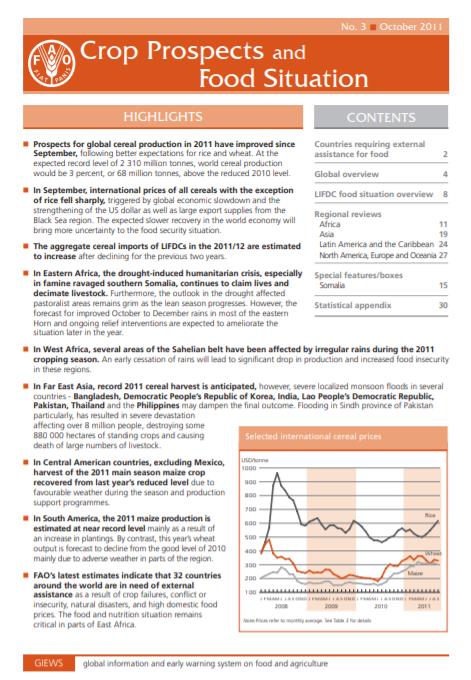
Crop Prospects and Food Situation #3, October 2011
06/10/2011
Prospects for global cereal production in 2011 have improved since September, following better expectations for rice and wheat. At the expected record level of 2 310 million tonnes, world cereal production would be 3 percent, or 68 million tonnes, above the reduced 2010 level. In September, international prices of all cereals with the exception of rice fell sharply, triggered by global economic slowdown and the strengthening of the US dollar as well as large export supplies from the Black Sea region. The expected slower recovery in the world economy will bring more uncertainty to the food security situation. The aggregate cereal imports of LIFDCs in the 2011/12 are estimated to increase after declining for the previous two years.
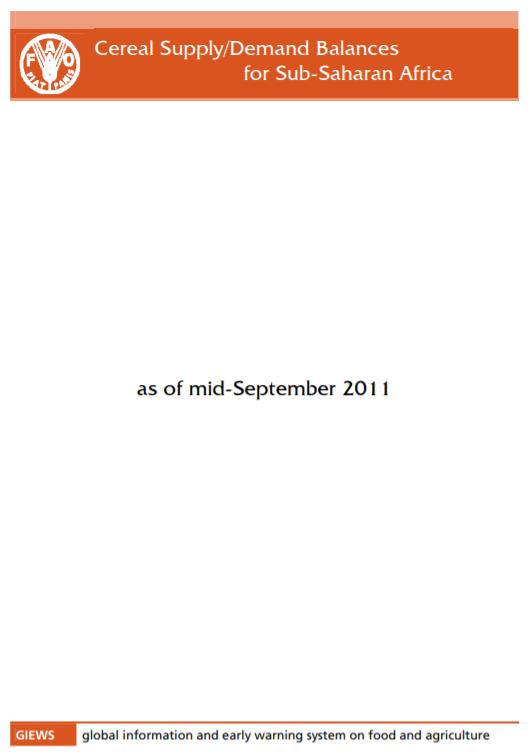
Cereal supply and demand balances for sub-Saharan African countries - No.3, September 2011
22/09/2011
The FAO/GIEWS Country Cereal Balance System (CCBS) is a database of annual supply and utilization balances for main cereals, covering all countries of the world. It has been maintained by FAO/GIEWS since 1980 and is updated on a continual basis. This statistical report, which is a subset of CCBS data, presents the current-year cereal supply and demand balances for all sub-Saharan African countries, highlighting cereal import and food aid requirements of each country. This report is complement ary to the FAO/GIEWS report Crop Prospects and Food Situation and is published four times a year, with the same schedule.
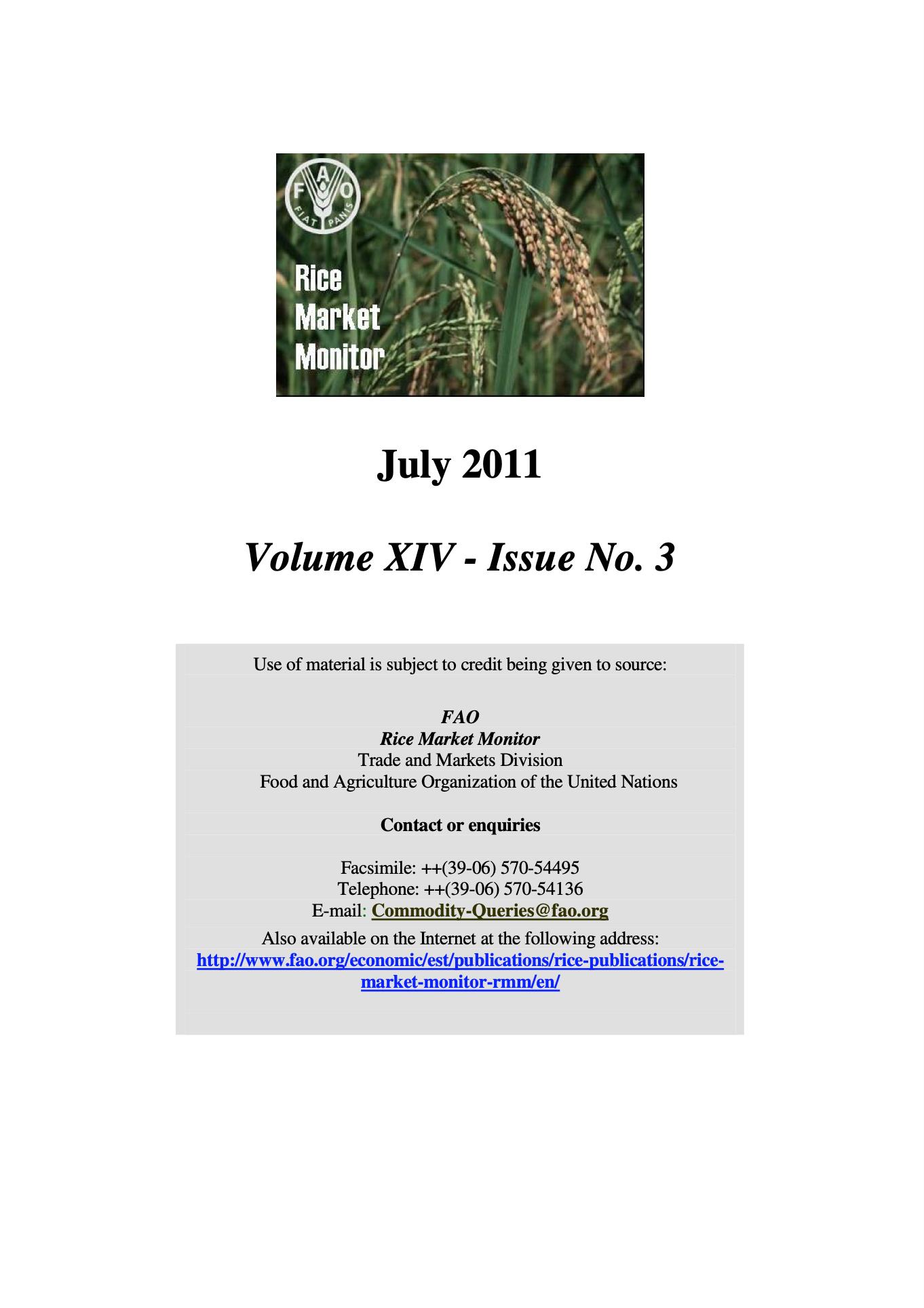
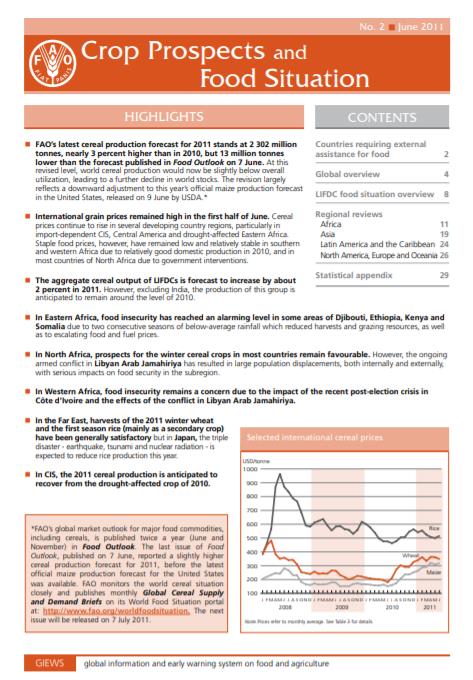
Crop Prospects and Food Situation #2, June 2011
09/06/2011
FAO’s latest cereal production forecast for 2011 stands at 2 302 million tonnes, nearly 3 percent higher than in 2010, but 13 million tonnes lower than the forecast published in Food Outlook on 7 June. At this revised level, world cereal production would now be slightly below overall utilization, leading to a further decline in world stocks. The revision largely reflects a downward adjustment to this year’s official maize production forecast in the United States, released on 9 June by USDA. International grain prices remained high in the first half of June. Cereal prices continue to rise in several developing country regions, particularly in import-dependent CIS, Central America and drought-affected Eastern Africa. Staple food prices, however, have remained low and relatively stable in southern and western Africa due to relatively good domestic production in 2010, and in most countries of North Africa due to government interventions. The aggregate cereal output of LIFDCs is forecast to increase by about 2 percent in 2011. However, excluding India, the production of this group is anticipated to remain around the level of 2010.
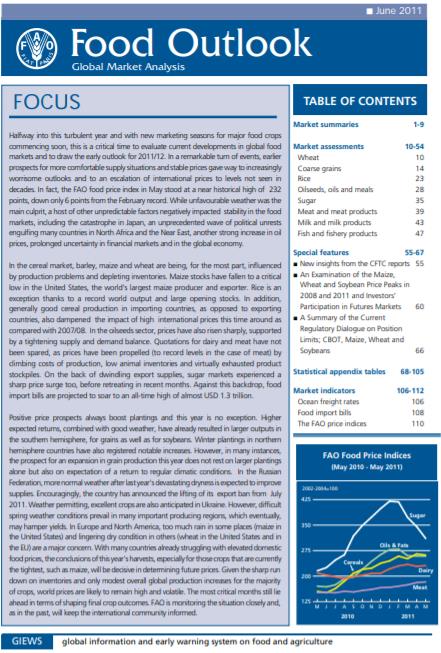
Food Outlook - June 2011
01/06/2011
Halfway into this turbulent year and with new marketing seasons for major food crops commencing soon, this is a critical time to evaluate current developments in global food markets and to draw the early outlook for 2011/12. In a remarkable turn of events, earlier prospects for more comfortable supply situations and stable prices gave way to increasingly worrisome outlooks and to an escalation of international prices to levels not seen in decades. In fact, the FAO food price index in May stood at a near historical high of 232 points, down only 6 points from the February record. While unfavourable weather was the main culprit, a host of other unpredictable factors negatively impacted stability in the food markets, including the catastrophe in Japan, an unprecedented wave of political unrests engulfing many countries in North Africa and the Near East, another strong increase in oil prices, prolonged uncertainty in financial markets and in the global economy.
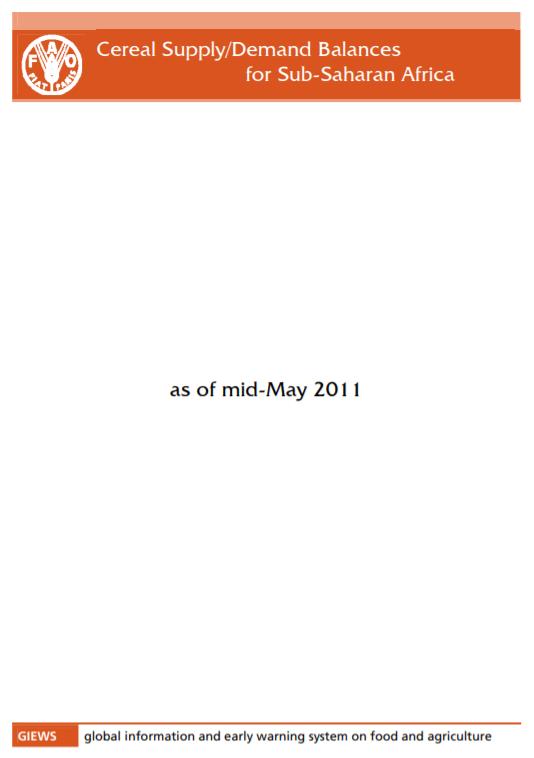
Cereal supply and demand balances for sub-Saharan African countries - No.2, May 2011
19/05/2011
The FAO/GIEWS Country Cereal Balance System (CCBS) is a database of annual supply and utilization balances for main cereals, covering all countries of the world. It has been maintained by FAO/GIEWS since 1980 and is updated on a continual basis. This statistical report, which is a subset of CCBS data, presents the current-year cereal supply and demand balances for all sub-Saharan African countries, highlighting cereal import and food aid requirements of each country. This report is complement ary to the FAO/GIEWS report Crop Prospects and Food Situation and is published four times a year, with the same schedule.
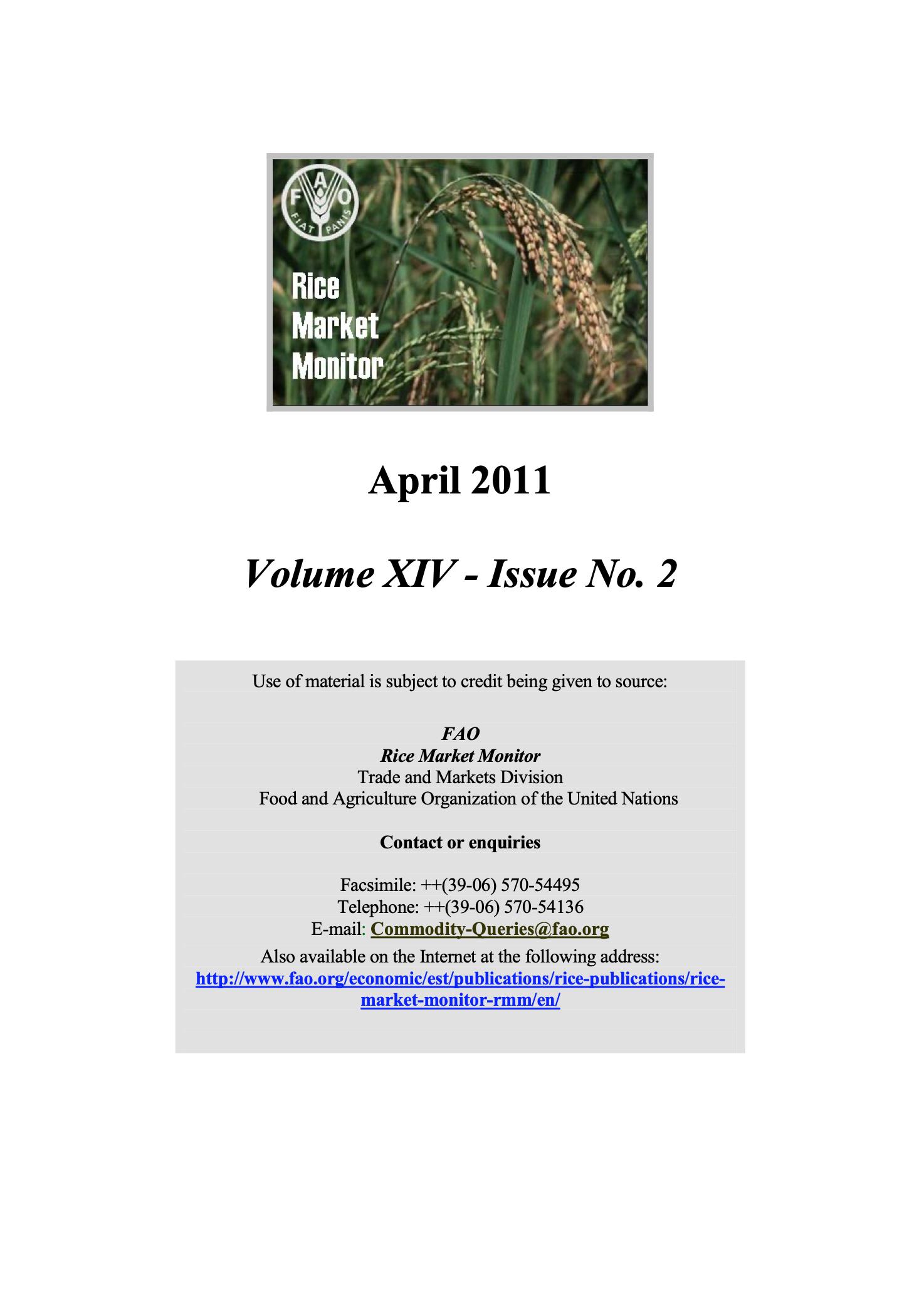
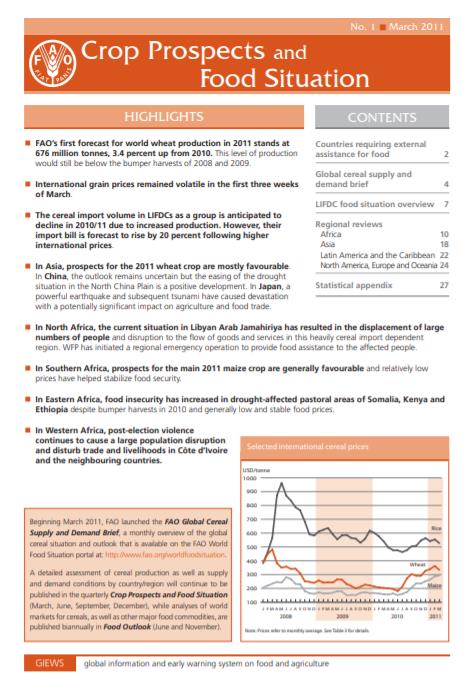
Crop Prospects and Food Situation #1, March 2011
10/03/2011
FAO’s first forecast for world wheat production in 2011 stands at 676 million tonnes, 3.4 percent up from 2010. This level of production would still be below the bumper harvests of 2008 and 2009. International grain prices remained volatile in the first three weeks of March. The cereal import volume in LIFDCs as a group is anticipated to decline in 2010/11 due to increased production. However, their import bill is forecast to rise by 20 percent following higher international prices.
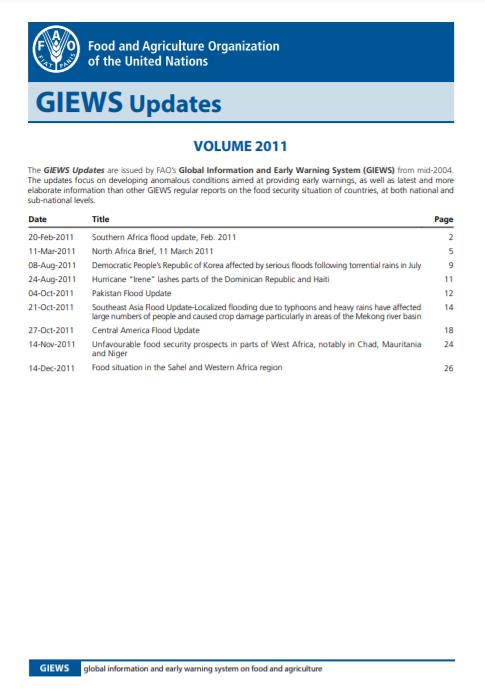
GIEWS Updates - Volume 2011
21/02/2011
The GIEWS Updates are issued by FAO’s Global Information and Early Warning System (GIEWS) from mid-2004. The updates focus on developing anomalous conditions aimed at providing early warnings, as well as latest and more elaborate information than other GIEWS regular reports on the food security situation of countries, at both national and sub-national levels.
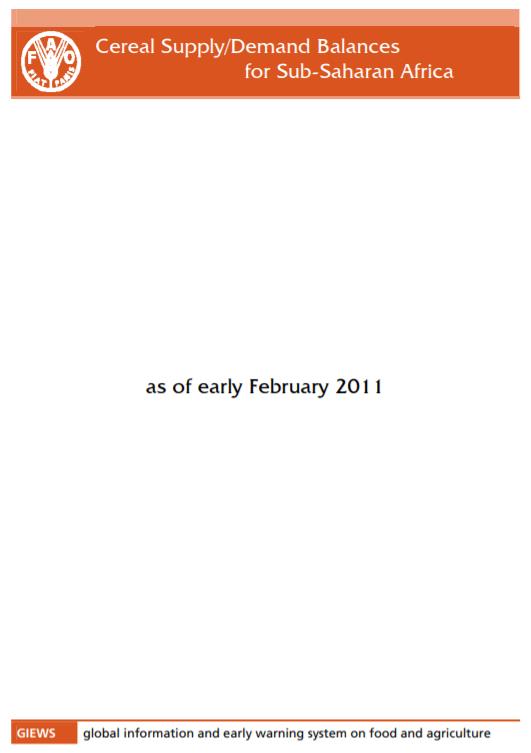
Cereal supply and demand balances for sub-Saharan African countries - No.1, February 2011
10/02/2011
The FAO/GIEWS Country Cereal Balance System (CCBS) is a database of annual supply and utilization balances for main cereals, covering all countries of the world. It has been maintained by FAO/GIEWS since 1980 and is updated on a continual basis. This statistical report, which is a subset of CCBS data, presents the current-year cereal supply and demand balances for all sub-Saharan African countries, highlighting cereal import and food aid requirements of each country. This report is complement ary to the FAO/GIEWS report Crop Prospects and Food Situation and is published four times a year, with the same schedule.
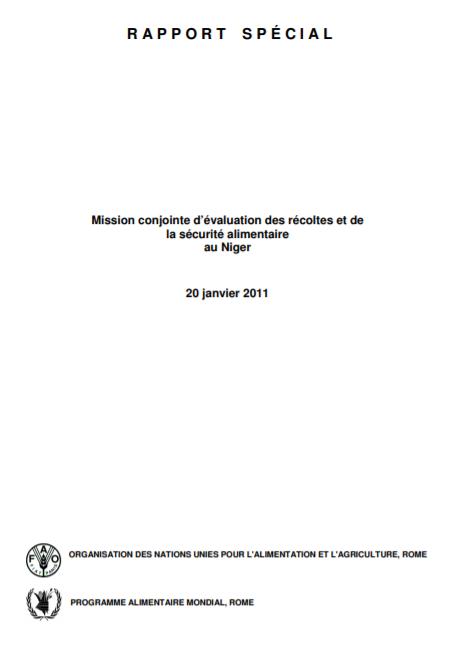
Rapport Spécial- Mission conjointe d’évaluation des récoltes et de la sécurité alimentaire au Niger
20/01/2011
La mission conjointe FAO/PAM/CILSS/FEWS NET a visité le pays du 18 octobre au 6 novembre 2010. Durant la première semaine, les experts et représentants de la FAO, du PAM, du CILSS-AGRHYMET et de FEWS NET en collaboration avec les responsables des ministères, ont adopté le programme de travail de la mission et ont tenu des séances de travail avec les services nationaux intervenant dans le suivi de la campagne agricole, la prévision des récoltes et la sécurité alimentaire. Une rencontre a été organisée avec le Groupe de travail pluridisciplinaire (GTP) à laquelle ont assisté les représentants de la Direction de la protection des végétaux (DPV), la Direction des cultures vivrières (DCV), la Météorologie nationale, le Système d’alerte précoce (SAP), le Dispositif National de Prévention et de Gestion des Crises Alimentaires (DNPGCA), les Systèmes d’information de marchés de bétail (SIM Bétail) et de marchés agricoles (SIM), la Direction des statistiques agricoles et la Direction des Ressources en Eau. La Mission a bénéficié de l’appui de toutes les directions centrales et régionales du Ministère de l’agriculture et de l’élevage ainsi que l’appui des autres services et ministères sollicités.
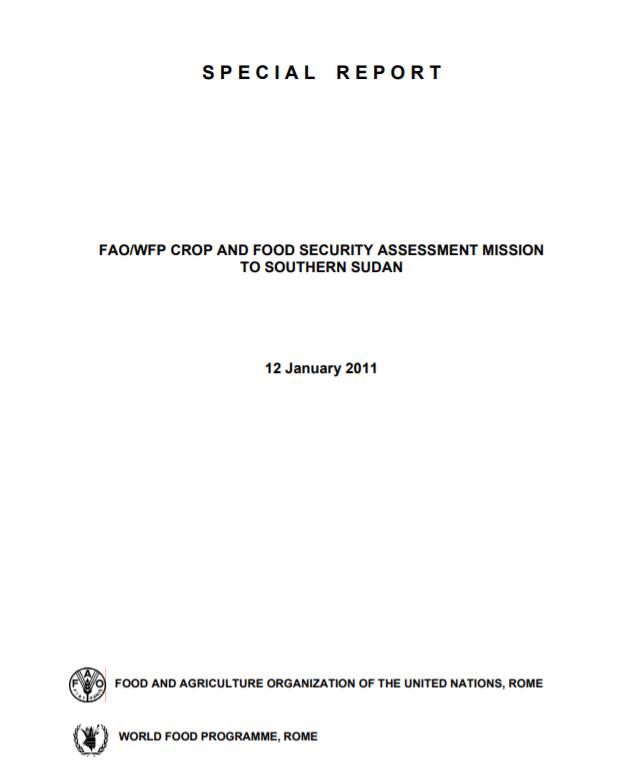
Special Report - FAO/WFP Crop and Food Security Assessment Mission to Southern Sudan - 12 January 2011
11/01/2011
An FAO/WFP Crop and Food Security Assessment Mission (CFSAM) visited Southern Sudan from 18 October to 12 November 2010 to estimate cereal production and assess the overall food-security situation. The Mission included representatives from the Government of Southern Sudan (GoSS), the Ministry of Agriculture and Forestry (MoAF), the Southern Sudan Relief and rehabilitation Commission (SSRRC), the Southern Sudan Centre for Census, Statistics and Evaluation (SSCCSE) FEWS/NET, EC/JRC, FAO and WFP. The Mission held meetings with officials of various ministries including the MoAF, the Ministry of Animal Resources and Fisheries (MARF), SSRRC, SSCCSE as well as UN and other international agencies. Location-specific information was obtained from relevant state and local authorities such as the SSRRC, the state Ministries of Agriculture (SMoA) and NGOs. The Mission benefited from the findings of the mid-season Rapid Crop Assessment (RCA) by GoSS, MoAF, SSRRC, SSCCSE, FAO and WFP, the 2009 and 2010 Annual Needs and Livelihood Assessments (ANLA), the 2009 National Household Budget Survey and the Situation Analysis of Nutrition in Southern Sudan.
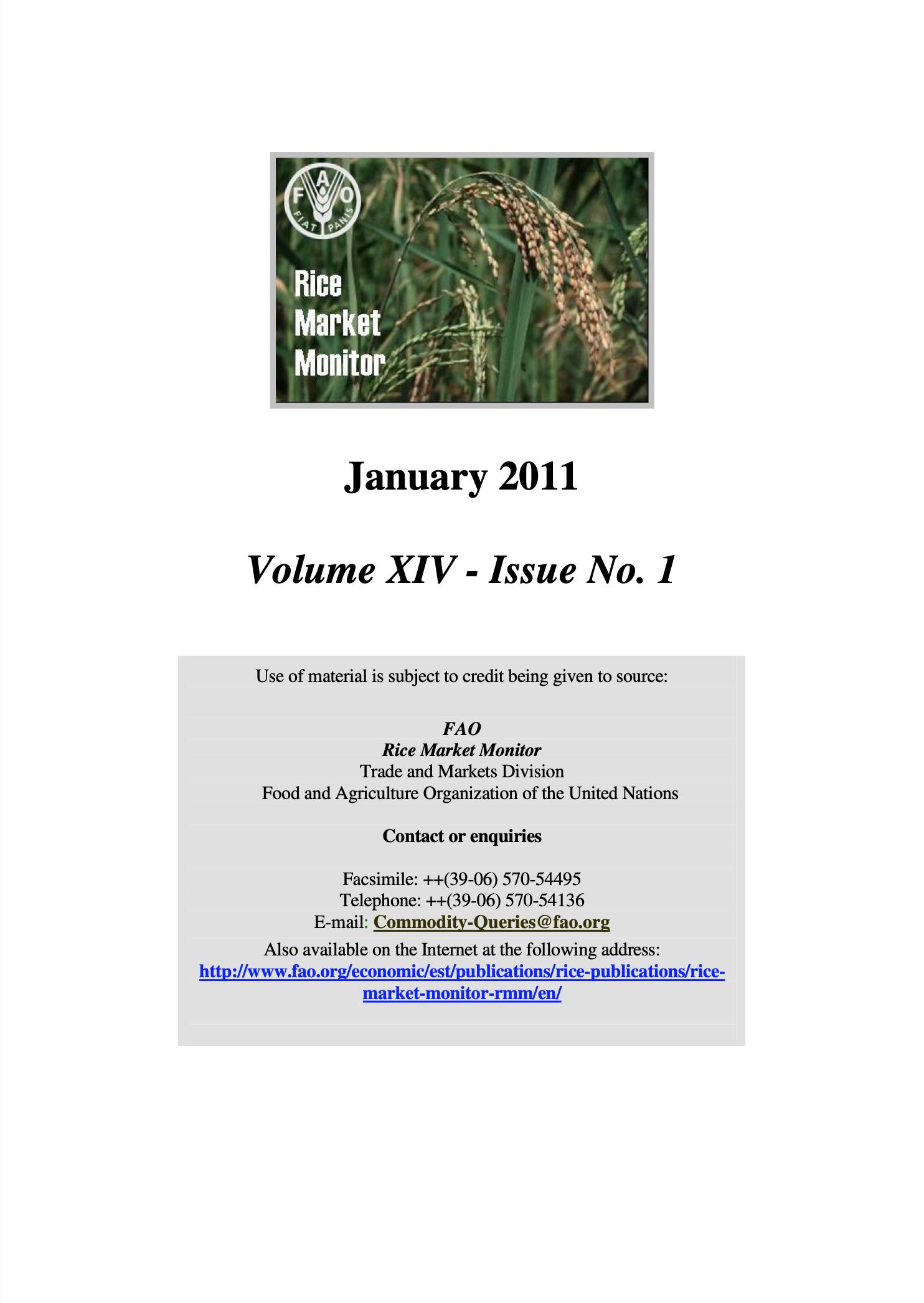
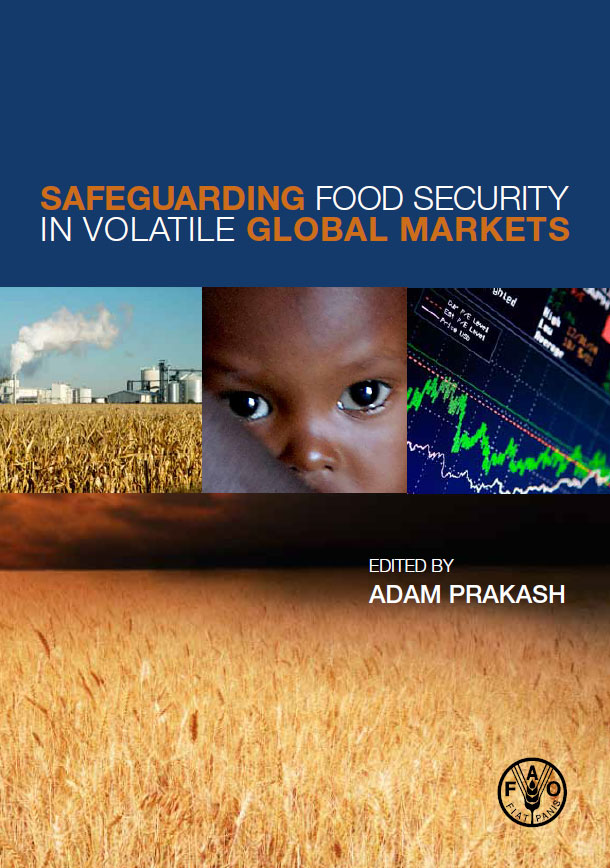
Safeguarding food security in volatile global markets
01/01/2011
A timely publication as world leaders deliberate the causes of the latest bouts of food price volatility and search for solutions that address the recent velocity of financial, economic, political, demographic, and climatic change.
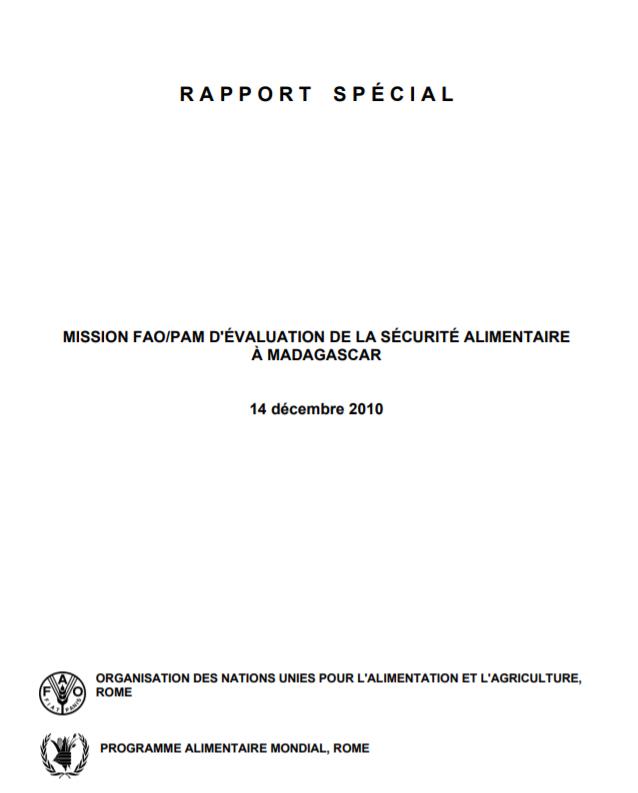
Rapport Spécial - Mission FAO/PAM D'évaluation de la Sécurité Alimentaire à Madagascar
14/12/2010
Une mission FAO/PAM composée de cadres techniques du Ministère de l’agriculture, ainsi que des consultants (PAM/FAO) a été conduite à Madagascar du 28 juin au 31 juillet 2010, avec pour objet l’évaluation des récoltes et de la sécurité alimentaire dans le pays pour la campagne agricole 2009/10. Dans cette optique, la mission devait identifier et évaluer les facteurs influant sur la production agricole tels que la pluviométrie, les maladies et ennemis des plantes, l’approvisionnement en intrants agricoles, l‘encadrement des producteurs, les circuits de commercialisation et les conditions d’accès des ménages aux denrées alimentaires de base. Dans son rapport, elle devait dresser un bilan de la demande et de l’offre des céréales au niveau national, identifier les zones et les ménages sujets à l’insécurité alimentaire et proposer des solutions appropriées.
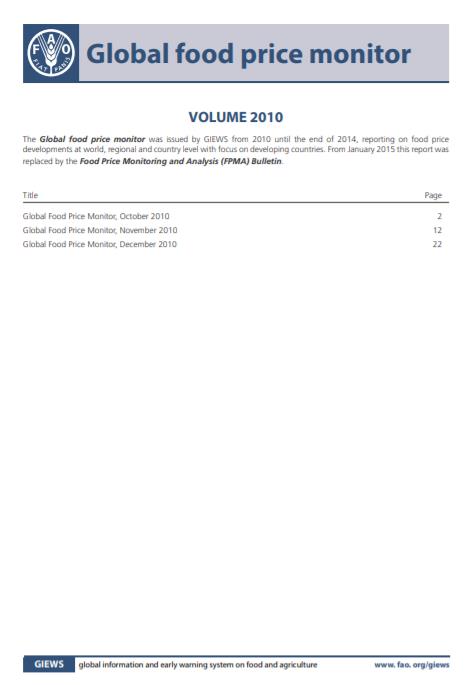
Global food price monitor - Volume 2010
09/12/2010
The Global food price monitor was issued by GIEWS from 2010 until the end of 2014, reporting on food price developments at world, regional and country level with focus on developing countries. From January 2015 this report was replaced by the Food Price Monitoring and Analysis (FPMA) Bulletin.
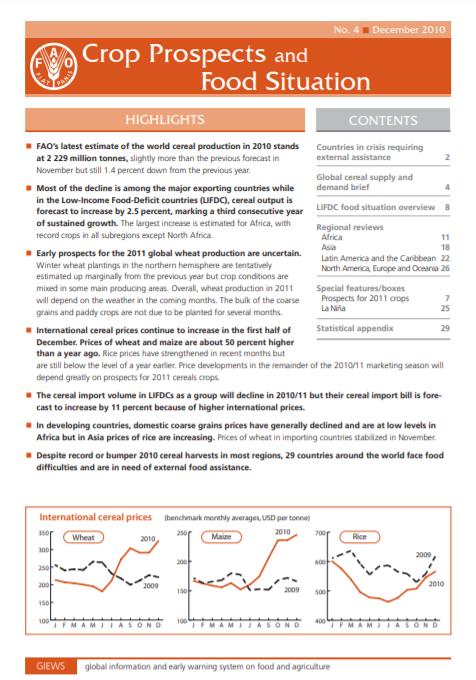
Crop Prospects and Food Situation #4, December 2010
09/12/2010
FAO’s latest estimate of the world cereal production in 2010 stands at 2 229 million tonnes, slightly more than the previous forecast in November but still 1.4 percent down from the previous year. Most of the decline is among the major exporting countries while in the Low-Income Food-Deficit countries (LIFDC), cereal output is forecast to increase by 2.5 percent, marking a third consecutive year of sustained growth. The largest increase is estimated for Africa, with record crops in all subregions except North Africa.
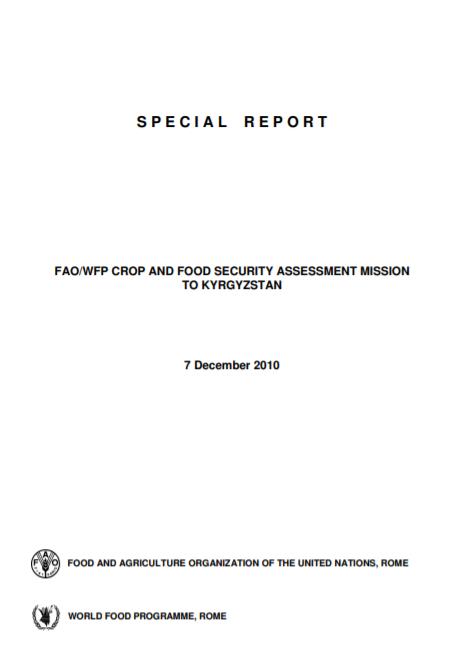
Special Report - FAO/WFP Crop and Food Security Assessment Mission to Kyrgyzstan
07/12/2010
Following a request from the Kyrgyz Ministry of Agriculture (MoA) to assess the impact on agriculture and food security of the late start of the spring 2010 season and social unrest in April and June, and to provide technical assistance in rapid crop assessment methodologies, an FAO/WFP Crop and Food Security Assessment Mission was conducted in Kyrgyzstan in July and August 2010. The Mission was to support a crop cutting and assessment exercise conducted in parallel of the regular National Statistical Committee (NSC) survey; estimate the 2010 winter and spring cereal production; assess the overall food supply situation; estimate cereal import requirements for the 2010/11 marketing year (July/June). The assessment of the household food security was based on key results of a WFP Emergency Food Security Assessment (EFSA) on the prevalence of food insecurity and its causes undertook in late July.

